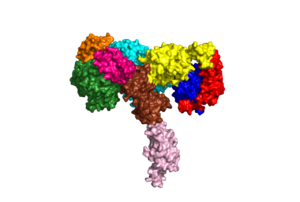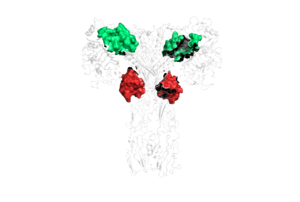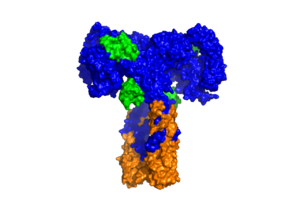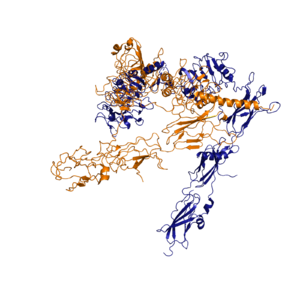Function of the Receptor
The insulin receptor is a transmembrane receptor that resides in the plasma membrane and is activated by the binding of insulin.[1] The insulin receptor belongs to the large class of receptor tyrosine kinase (RTKs). RTKs are found at the cell surface and have a high affinity for a particular ligand. RTKs are made up of three distinct parts: an extracellular domain with ligand binding sites, a transmembrane region, and an intracellular domain with the tyrosine kinases that initiate intracellular signaling cascades.[1]
The insulin receptor binds the insulin hormone and initiates a cascade of events within the cell. The receptor resides within the plasma membrane of insulin targeted cells. These cells are found in various organs, such as the liver, and tissues, including skeletal muscle and adipose.[2] The insulin receptor is activated by multiple insulin molecules binding to various sites on the receptor.[3] Once activated, the receptor serves as the gateway for the regulation of various cellular processes including glucose transport, glycogen storage, autophagy, apoptosis, and gene expression. Additionally, problems with the insulin receptor are associated with the development of diseases such as Alzheimer's, type II diabetes, and cancer.[4]
Through recent cryo-EM structures of the insulin receptor bound in various conformations, a complete three-dimensional understanding of the conformational changes in the insulin receptor upon insulin binding are finally coming into focus. Evaluation of the structural composition and the biochemical properties of the insulin receptor reveals details about the role of the receptor in crucial cellular processes.
See also Kinase-linked, enzyme-linked and related receptors, Insulin signal transduction pathway
Insulin
is a hormone made of two separate amino acid chains that are bound by multiple disulfide bonds. Insulin is synthesized and secreted from the islets of Langerhans of the pancreas in response to high concentrations of glucose in the blood. Once it is secreted, insulin moves through the bloodstream and binds to unactivated insulin receptors residing in the plasma membrane. Binding of insulin to the insulin receptor is a complex process, which involves negative cooperativity among insulin molecules.[1] [3] [5] Current hypotheses propose that the receptor is fully activated only after multiple insulin molecules are bound.[3] The binding of the increased amount of insulin to the insulin receptors will activate their downstream pathways to initiate glucose uptake by the phosphorylation of the Insulin Receptor Substrate (IRS).[6] The transport of extracellular glucose into the cell allows this glucose to be converted to glycogen for storage and later usage.
Insulin Receptor Structural Overview
The insulin receptor is a dimer of made of two and two . [7] Within the extracellular ectodomain, there are four potential that can interact with insulin ligands on the extracellular side of the membrane. The full extracellular and intracellular components of the insulin receptor have only been imaged in separate sections but a larger picture of how these sections combine to initiate downstream tyrosine autophosphorylation is emerging.[8]
Alpha Subunits

Figure 1: Insulin receptor apo receptor. Site L1' is colored a dark green, CR' is orange, L2' is bright blue, L2 is yellow, CR is red, L1 is dark blue, FnIII-1 is brown, and FnIII-2 is light pink. Insulin is shown bound and is colored dark pink.
PDB 6CE7The make up the extracellular domain (ectodomain) of the insulin receptor and are the sites of insulin binding. The alpha subunit is comprised of two Leucine rich domains (L1 & L2), a Cysteine rich domain (CR), and a (Figure 1).[4] α-CT has a unique position that allows it to reach across the receptor and interact with the insulin at the binding site on the opposing side of the receptor. The alpha subunits are held together by a disulfide bond between on each alpha subunit. The disulfide bonds are important to the overall stabilization of the molecule as it binds to insulin. Two types of insulin binding sites are present in the alpha subunits, and (Figure 2). The sites are in pairs because of the heterodimeric nature of the receptor. Due to structural differences, as well as greater surface area and accessibility, binding sites 1 and 1' have much higher affinity for insulin binding than sites 2 and 2'. Insulin can also bind at sites 2 and 2', but the location on the back of the beta sheet of the FnIII-1 domain and lack of surface area decreases the likelihood of their binding site becoming occupied as quickly.[3]

Figure 2: The four binding sites of insulin. Sites 1 and 1' are colored green, sites 2 and 2' are colored red.
PDB 6SOF Beta Subunits
The spans from the extracellular domain across the transmembrane region and into the intracellular portion of the insulin receptor. The beta subunit is composed of part of fibronectin domain III-2 and all of Fibronectin domain III-3.[4] The beta subunit's FnIII-3 domain has links through the transmembrane region into the intracellular part of the membrane. Cryo-EM provided clear representations of the FnIII-2 and FnIII-3 domains (Figure 1) but are missing the transmembrane and intracellular regions. Although the FnIII-3 domain is connected to the transmembrane and intracellular regions, the active conformation (Figure 3) likely extends all the way to the tyrosine kinase domain region (see PDB 4XLV).[9]
Subunit Organization
The alpha and beta subunits of the extracellular domains fold over one another and form a when the insulin receptor is inactivated. Upon activation, the extracellular domain undergoes a conformational change and forms a . An additional component to the ectodomain is .[3] Each of the dimers has an α-CT helix. The α-CT helix is a single alpha-helix that plays an important role in insulin binding and stabilization of the "T" shape activated conformation. α-CT interacts with a leucine-rich region of the alpha subunit and a fibronectin type III region of the beta subunit to form the insulin binding sites known as .[3]
The structure of the extracellular domain is stabilized through multiple disulfide bonds. The alpha subunits are linked through two disulfide bonds, with the main one being between of two adjacent alpha subuntis [5]. of both alpha subunits are also held together with a disulfide bond.[10] The alpha subunit is also attached to the beta subunit by a disulfide bond between the .[10]
Function
Insulin Binding
The insulin receptor unit has four separate sites for the insulin binding. There are two pairs of two identical binding sites referred to as and .
The insulin molecules bind to these sites mostly through hydrophobic interactions, with some of the most crucial residues at sites 1 and 1' being between of the insulin receptor FnIII-1 domain.[3] Despite some of the residues included being charged, the main interactions are still hydrophobic in this binding site. For example, due to arginine carrying its positive charge at the end of the side chain, to allow the hydrophobic part of the side chain to interact with the other hydrophobic residues. The alpha subunits also have significant that help maintain a compact binging site. At sites 2 and 2', the major residues contributing to these hydrophobic interactions are the .[3]
Sites 1 and 1' have a higher binding affinity than sites 2 and 2' due to site 1 having a larger surface area (706 Å2) exposed for insulin to bind to compared to site 2 (394 Å2).[3] The binding interactions of the insulin molecules in sites 1 and 1' are facilitated by hydrophobic residues of an of the insulin receptor. The insulin molecules in sites 2 and 2' primarily interact with the residues that comprise some of the of the insulin receptor.

Figure 3: Surface representation of the insulin receptor in the active "T" shape conformation with four insulins bound (green).
PDB 6SOFAt , a occurs between three critical parts of the alpha subunits of the insulin receptor.[3] The entire interface of the tripartite interaction involves many residues that are involved with intra-protomer ionic and hydrogen bonding at the binding site. The α-CT chain and the FnIII-1 domain region come into close proximity during the conformational change of the insulin receptor and their interaction involves the following residues: and the . This duo then interacts with the L1 region, specifically ARG14, creating an ideal for the insulin ligand. The FnIII-1 and α-CT are interacting from the two different alpha subunits, which displays a "cross linking" scenario where the domains of the heterodimer can intertwine with each other. The tripartite interaction between α-CT, the FnIII-1 domain, and the L1 region is important because it allows for a strong interaction between two subunits of the insulin receptor that maintains and stabilizes the T-shape activation state for the rest of the downstream signaling to occur.[3]
It has been hypothesized that activation of the insulin receptor can change based on the concentration of insulin. These recent cryo-EM structures of the insulin receptor have demonstrated that at least three insulin molecules have to bind to the insulin receptor to induce the active conformation, as binding of two insulin molecules is insufficient to induce a full conformational change.[3] However, this conclusion has not yet been widely confirmed.[3] In low concentrations of insulin, the insulin receptor may not require binding of three insulin molecules in order to exhibit activation. Rather, the level of activity will change in accordance to the availability of insulin.[3] When higher concentrations of insulin are present, the conformational difference between the two-insulin-bound state and the three-insulin-bound state is drastic as the insulin receptor transitions from the inactive to the active .[3] However, in conditions of low insulin availability, the two-insulin-bound state may be enough to induce partial activation of the receptor.[3]
Conformational Changes
The conformational change between the inverted, inactive and the active of the insulin receptor is induced by insulin binding. The T shape conformation is well observed in the alpha subunit. It is horizontally composed of L1, CR (including the ), and L2 domains and vertically composed of the FnIII-1, 2, and 3 domains (Figure 1). The proper conformational change of the ectodomain of the insulin receptor is crucial for transmitting the signal into the cell. The movements extracellularly cause the two receptor tyrosine kinase domains intracellularly to become close enough to each other to autophosphorylate.[2] This autophosphorylation activates the tyrosine kinase domain, initiating intracellular insulin signaling cascades.[2]

Figure 4: Conformational change of insulin receptor protomer from inactive (blue) to active (orange) form upon insulin binding.
Inactive PDB 4ZXB Active PDB 6SOFWhen an insulin molecule binds to site 1 of the alpha subunit, the respective protomer is recruited and a slight inward movement of the of the beta subunit is initiated. This is accomplished by the formation of several salt bridges, specifically between .[3] Binding of insulin to both protomers establishes a full activation of the insulin receptor. This activation is demonstrated through the inward movement of both protomers. This motion has been referred to as a "hinge" motion as both protomers "swing" in towards one another.[3] Figure 4 depicts the conformational change and "hinge motion" between the inactive and active forms of an insulin receptor protomer. Upon insulin binding, the beta subunits of the inactive form, shown in blue, are "swung" inward to the active form, shown in orange. When the receptor is in an , the FnIII-3 domains are separated by about 120Å.[11] This distance prevents the initiation of autophosphorylation and downstream signaling by the tyrosine kinase domains on the intracellular side of the receptor. Upon the binding of insulin to multiple binding sites, this conformation change brings the FnIII-3 domains within 40Å of each other to induce the conformation.[3] [12] As the fibronectin type III domains of the beta subunit swing inward, the alpha subunits also undergo a conformational change upon insulin binding. As insulin binds to site 1, the leucine-rich region of one protomer interacts with α-CT and the FNIII-1 domains of the other protomer to form the binding site.[3] For the tripartite interface to form, the alpha subunits of each protomer must undergo a "folding" motion. While snapshots of various conformational states of the insulin receptor have been captured, the complex dynamics of the insulin receptor conformational changes upon insulin binding are still being actively investigated.[3]
Receptor Tyrosine Kinase Domain Structure and Links
(PDB entry 3bu5).
TK domain of IR contains an activation loop and a catalytic loop and . The bound IR substrate 2 peptide tyrosine is the phosphorylated residue[13].
In type 2 diabetes, the TK domain is thought to be down-regulated through phosphorylation of by protein kinase C[14].
. Water molecules shown as red spheres.
See also Insulin Receptor - kinase domain (Hebrew) and Insulin receptor (Hebrew).
The β-chain contains a tyrosine kinase catalytic domain (TK) residues 1005-1310. For more details see Student Projects for UMass Chemistry 423 Spring 2012-1.
Biological Relevance
In a healthy individual, insulin secretion and binding to the insulin receptor initiates a robust physiological response. Improper insulin signaling leads to multiple disease states, including diabetes. Type 1 diabetes is classified as "insulin dependent" and involves an inability for the body to produce insulin, resulting from damage or insufficiency in the Islets of Langerhans in the pancreas. Type 2 diabetes is classified as "insulin independent" and is the result of the body producing insufficient amounts of insulin, or not responding to the insulin.
Type II Diabetes
Type II diabetes (T2D) is a chronic condition that affects 10 percent of the world's population.[2] T2D is characterized by insulin resistance and leads to high concentrations of glucose in the bloodstream. A type II diabetic produces insulin, but when the insulin molecule binds to the insulin receptor, the signal is not properly transmitted intracellularly. Insulin resistance in routine type II diabetics is not associated with mutations of the insulin receptor gene, but instead, the signal being disrupted later in the pathway. Mutations of the receptor gene are associated with more severe cases of insulin resistance, as seen in leprechaunism. Additionally, mutations of the insulin receptor can be fatal, as it is crucial for many cellular processes including gene expression, glucose homeostasis, and apoptosis. The basis for insulin resistance in typical type II diabetics is complex and cannot yet be explained by one particular factor.[2] [15]
There are a multitude of hypotheses which discuss the reasons for the establishment of type II diabetes.[2] [15] While the specifics of the development of T2D are beyond the scope of this page, the molecular causes for insulin resistance and T2D have been primarily attributed to the inhibition of key proteins involved in the insulin signaling and glucose transport pathway.[2] Alterations to the phosphorylation cascade of insulin signaling can be the result of changes within the cellular environment including lipotoxicity, inflammation, hyperglycemia, and the presence of reactive oxygen species (ROS).[2] On a macroscopic level, a variety of factors influence the cellular environment, and thus the risk for T2D. These factors include gestational environment, microbiome, genetics, diet, and energy expenditure.[15] Recent studies, which have evaluated the relationships between genetics and environmental factors in the progress of T2D, have shown that T2D is not uniform among the population and the biochemistry behind the development of risk factors varies for each patient.[15]
3D structures of insulin receptor
Insulin receptor 3D structures




